South Africa
About Andrew Cusack
 Writer, web designer, etc.; born in New York; educated in Argentina, Scotland, and South Africa; now based in London.
Writer, web designer, etc.; born in New York; educated in Argentina, Scotland, and South Africa; now based in London. read more
News
Blogs
Reviews & Periodicals
Arts & Design
World
France
Mitteleuropa
Knickerbockers
Argentina
The Levant
Africa
Cape of Good Hope
Netherlands
Scandinavia
Québec
India
Muscovy
Germany
Academica
‘Don’t expect the busy Big Apple…’
Cape Town Tourism organised the My Cape Town Video Competition “inviting aspirant moviemakers to get out and about as tourists in their own city and capture their experience in video format”. The winning entry from Cat Pritchard and Charlton Cleophas — “Ode to Cape Town” — is less than 45 seconds long. My favourite line, which perfectly expresses why I prefer Cape Town to New York: “Now don’t expect the busy Big Apple — we prefer the slow, cultured grape.”
David Goldblatt: Structures
“THE FIRST GROUP of photographs that I attempted of structures,” writes photographer David Goldblatt, “was a series made in 1961 on places of worship on the Witwatersrand. I came to this from two starting points. The first was a fascination with the idea of faith. Notwithstanding recurrent nightmares during childhood about the infiniteness of everlasting hellfire and uncertainty over the domicile of my unbaptised Jewish soul in the hereafter, arising from an otherwise happy primary school education by nuns, I don’t think I was ever able to believe in or pray to the deity with much conviction — except momentarily under extreme threat of imminent disaster. Neither nuns nor rabbi could ever enable me to transcend the banal with that leap of faith required of true believers. … I was — am — then, generally sceptical of believers’ beliefs but also in awe, and sometimes envious, of their ability to believe. If blind, unreasoning faith often repels me it sometimes moves and always intrigues.”
“Thus it was endlessly mysterious, even incredible to me that people — for the most part ‘ordinary’, ‘practical’ people, probably not much given to abstruse thought and discussion — should pour such effort and resource into the erection of structures devoted to so abstract an idea as God.” The photographer, understandably, doesn’t understand that, for we Christians, God is no less abstract than our father, mother, or neighbour down the street. “The ubiquity and persistence of the phenomenon, the immensity of humankind’s investment in God was to me quite awesome.”
“The second starting point for this early series of photographs of structures was an inchoate but growing awareness that whereas some structures seemed quite detached from this place, the Witwatersrand or, more broadly, South Africa, others grew almost viscerally from it. This seemed to have less to do with architecture than with indefinable qualities of ‘belonging’. I wanted to explore these notions and bring them into the light with the camera.” (more…)
Fellowes Prynne in Johannesburg
A Rejected Proposal for St. Mary’s Anglican Church
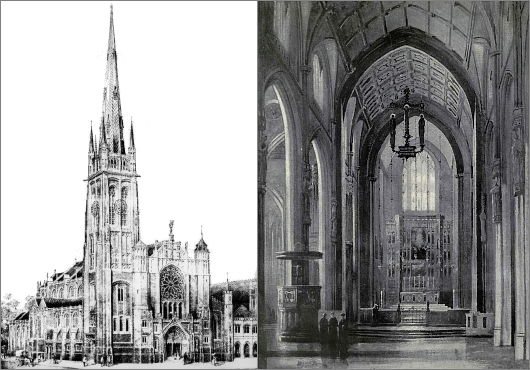
We rarely mention Johannesburg on this little corner of the web because our mother taught us that if you don’t have anything nice to say, don’t say anything at all. While ruffling through the archives the other day, however, I came across this design for the Johannesburg cathedral of the Church of the Province of South Africa. George Halford Fellowes Prynne (1853–1927) was an accomplished Gothic architect whose work is mostly found in the south of England. He’s notable for his rood screens in particular, worked in a variety of forms and materials (wood, stone, and metal), though this design employs a hanging rood. (more…)
‘Today It Feels Good to be An African’
I REMEMBER, shortly after President Mbeki’s resignation, conversing with a friend of mine, an Afrikaner vrou more advanced in years & experience than I. In response to my expression of ‘good riddance’ to an administration marked mostly by a detached aloofness and a willingness to abuse the prosecutorial system, this creature of the soil replied calmly, “Ah, but we will learn to miss Mr. Mbeki.” And, while I trust the instincts of Mr. Zuma more than the education of Mr. Mbeki, listening to the 1996 speech in which the latter commended the Constitution Bill to the National Assembly I can at least concede readily the eloquence of the former president.
The excerpt above was produced by South African Tourism, and ably displays the beauty of the country — “the hills and the valleys, the mountains and the glades, the rivers, the deserts, the trees, the flowers, the seas, and the ever changing seasons” as Mr. Mbeki put it — and its people: the riders on Noordhoek strand, the Dutch Reformed predikant, the proud Coloured fisherman, the Xhosa women with their pipes, a Zionist baptism on the shore, the Durban party girls driving down the boulevard. South Africa is a country that sells itself; when it’s bloody, it’s bloody, but when it’s beautiful, it’s beautiful.
Zuma in Orania
President is Welcomed at Afrikaners-Only Enclave in Northern Cape
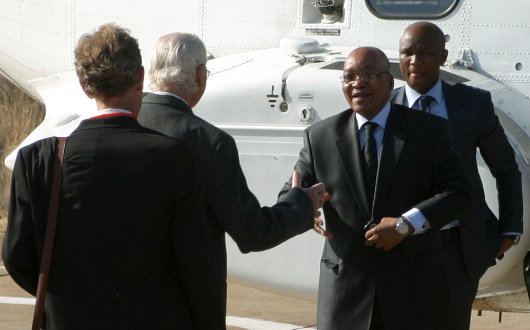
President Zuma yesterday paid a ‘goodwill visit’ to the whites-only Afrikaner enclave of Orania in the Northern Cape. The trip was prompted when Pres. Zuma received word that the town’s founded Prof. Carel Boshoff IV, was in poor health. Orania was founded in 1990, some months after whites voted to dismantle apartheid, as a place where Afrikaner self-reliance could be practiced and cultural heritage preserved. The town has pioneered various agricultural and ecological projects, and in 2004 started its own local currency, the Ora, which is equal to ten rand. (more…)
Stellenbosch in the ‘Cyclopædia’
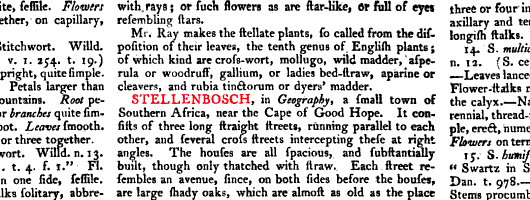
Over at afrikaans.be, Anton Raath posts a verbal snapshot of Stellenbosch in 1819 from ‘The Cyclopædia: or universal dictionary of arts, sciences, and literature’:
STELLENBOSCH, in Geography, a small town of Southern Africa, near the Cape of Good Hope. It consists of three long straight streets, running parallel to each other, and several cross streets intercepting these at right angles. The houses are all spacious, and substantially built, though only thatched with straw.
Each street resembles an avenue, since, on both sides before the houses, are large sturdy oaks, which are almost as old as the place itself, which was built at the beginning of the former century, though it was wholly burnt down in 1710. In December, 1803, a similar accident happened, when the number of houses left standing was about 80. The church was built in 1722, and though not equal in size to the churches of Roodezant and Paarl, it is no way inferior to them in point of architecture.
The number of inhabitants at Stellenbosch, including slaves and Hottentots, is estimated at 1000. Every person in this town carries on, with his trade, some portion of agriculture and horticulture; and as there are none who can be called actually poor, who labour for hire, they are obliged to have slaves, who do not pay the expence of keeping them.
Strangers, who in their long voyages make any stay at the Cape, never fail to visit Stellenbosch; and people of property at the Cape Town also, in the fine season of the year, often make parties of pleasure to this fertile spot. Hence houses are fitted up here for the accommodation and entertainment of strangers.
“Hoe meer dinge verander…” Mnr Raath comments.
Zuma: Government Will Mediatise Six of South Africa’s Monarchies
Six of South Africa’s thirteen monarchies are to be mediatised, the country’s president announced in July. A report by the Commission on Traditional Leadership Disputes and Claims of the South African government concluded that the six dynasties had been raised from chiefdoms to monarchies by the apartheid government for purely political reasons and suggested that their government funding and recognition be ended. President Zuma said the aim of the move was to correct “the wrongs of the past” but that no one was being accused of collaboration with the apartheid authorities. The six incumbent rulers will retain their styles and dignities while their successors will revert to the rank of princely chiefs.
“We have been waiting for this decision for a long time,” Khosi Fhumulani Kutama, the Chairman of the National House of Traditional Leaders told the media. “It is important that people accept it not only for the institution of traditional leadership but for the whole country.”
But the indications so far are that the six monarchies will take the government to court in an attempt to forestall the demotion.
Up to this point, the most significant spate of mediatisation was during the Napoleonic era, when Talleyrand arranged the demotion and reorganisation of conquered German lands.
The Lion’s Gate
VISITORS TO CAPE TOWN may be surprised that, given the beauty and multiplicity of animals in the vicinity, the ‘Mother City’ has no zoo. There is actually a popular zoo at Tygerberg, twenty-four miles from Cape Town and less than ten miles from Stellenbosch, which is the only zoo in the province. But centuries ago — around 1700 — a ‘menagerie’ was founded in the Company’s Gardens in Cape Town which survived for over a hundred years.
François Valentijn, in his visit of 1714, noted the menagerie boasted a pair of ‘rheen’ or ‘rheebokken’ (probably kudu), a black rhinoceros, an eland, a ‘rossen bok’ (possibly a hartebeest), a hippopotamus, two lions, and a zebra. In the 1770s, the Swede Anders Sparrman noted the presence of many springbok, a warthog, some ostriches, and even a cassowary. The selection varied widely through the years, and given Cape Town’s status as ‘The Tavern of the Seas’ central to the European route to the Indies and the Far East, the zoo included not only African beasts but also some (like the Papuan cassowary) brought from the Orient.
In 1777, the notorious rake William Hickey ventured to extoll it as “the finest menagerie in the world, in which are collected the most extraordinary animals and birds of every quarter of the globe”. Less than fifteen years later, however, Lt. George Tobin of the Royal Navy described it as “a menagerie of some extent. It was but poorly supplied, there being but a few ostriches and some different kinds of deer.” Decades later, in February 1825, a traveller noted the menagerie in the pages of the Montly Magazine of London:
At the end of the Grand Walk, which is nearly three-quarters of a mile long, is the Company’s Menagerie, which is worth seeing, on account of a good-natured old lion, supposed to be the largest ever taken into captivity, and a tiger of immense size and power; there are several other specimens of African animals: but those are infinitely the largest of their species I ever saw—we have nothing that comes near them in England.
A spiritually inclined passer-through, the Rev. Henry Martyn, Chaplain to the Honourable East India Company, stated in 1832 that the “lion and a lioness, amongst the beasts, and the ostrich, led my thoughts very strongly to admire and glorify the power of the great Creator.” It was around that time that Sir Benjamin d’Urban, Governor of the Cape, granted land next to the menagerie for the erection of a building for the South African College, the germ of what would become the University of Cape Town. This was the beginning of what is now called the Hiddingh campus of UCT, the institution’s first home which continues alongside the main campus built on the Rhodes estate on the slopes of Devil’s Peak. The menagerie was shut in 1838 and the first building of the proto-UCT went up the next year in an exotic Egyptian Revival style.
The lion gates, however, are from earlier. They were built in 1805, probably by Thibault, with the lions & lionesses sculpted by the architect’s frequent collaborator Anton Anreith, also responsible for the magnificent pulpit in the Groote Kerk. The lionesses on the UCT side are original but the lions on the other side, curiously, were removed in 1873. In 1958 they were restored when Ivan Mitford-Barberton — arguably South Africa’s greatest sculptor after Anreith — created new beasts for the old perches. The gates are still there if you walk up the Government Avenue that bisects the Company’s Gardens, beautiful in the eye of this beholder in their immaculate, white, classical elegance.
The Academic Portraits of Cyril Coetzee
A Selection of University Portraiture by the South African Painter
THE ART SCENE in South Africa is widely varied in both style and quality, and the individual artist who is devoted solely to a single school is almost rare. The works of Cyril Coetzee (born in 1959) vary from quasi-figurative explorations of colour dynamics to multi-layered, almost mythological narrative paintings. His academic research at Rhodes University, located in his Eastern Cape hometown of Grahamstown, explored anthroposophic colour theory, so it’s no surprise part of his further studies were undertaken at the Goetheanum in Dornach, Switzerland (one of the sites covered in Stephen Klimczuk & Gerald Warner of Craigenmaddie’s Secret Places, Hidden Sanctuaries). Coetzee’s corpus also include a number of purely figurative portraits, many of which were commissioned by places of learning in South Africa. (more…)
Stellenbosch Scientists Invent Cheap & Easy Water Filtration for the Masses
Prof. Eugene Cloete and his colleagues at the Water Institute of the University of Stellenbosch have come up with a helpful solution to the problem of drinking water in developing countries. The professor invented an inexpensive, teabag-like sac of nano-fibres — each about one hundredth the width of a human hair — which is secured into the lid of a reusable vessel. The water then passes through the filter secured in the lid and is thereby purified and made much more potable for human consumption.
The importance of the breakthrough is not only in its ease, but in its cheapness. Prof. Cloete estimates it would cost just three cents a litre to produce water that is the same quality level as bottled water (If he means three ZAR cents, then that is about equivalent to half a U.S. dollar cent — half a penny). Numerous foundations have expressed interest in a major roll-out of the cheap and efficient new filter system invented at Stellenbosch University.
In the video above, Prof. Eugene Cloete and Dr. Marelizes Botes explain the use and the science of the teabag filter, though I’m afraid the science of it goes a bit beyond my layman’s knowledge. The professor does manage to work in a bit of Afrikaans at the end of the video though.
Interesting Things Elsewhere
This determined Celt is gunning for Thabo
Kevin Bloom | The Daily Maverick
Ireland’s 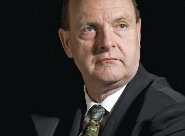 Paul O’Sullivan took over as head of security at South Africa’s airport authority in 2001, and discovered something was wrong from the start: why didn’t the policeman on duty want to take a statement about the attempted theft of his baggage? Since then, his life has been a series of bizarre events leading him ever deeper into the most complex criminal network of the post-apartheid era, including the recent the trial and conviction of former national police chief Jackie Selebi. But O’Sullivan’s determined quest to expose crookedness isn’t over yet, and he now has former president Thabo Mbeki in his sights. read more
Paul O’Sullivan took over as head of security at South Africa’s airport authority in 2001, and discovered something was wrong from the start: why didn’t the policeman on duty want to take a statement about the attempted theft of his baggage? Since then, his life has been a series of bizarre events leading him ever deeper into the most complex criminal network of the post-apartheid era, including the recent the trial and conviction of former national police chief Jackie Selebi. But O’Sullivan’s determined quest to expose crookedness isn’t over yet, and he now has former president Thabo Mbeki in his sights. read more
The apparatus of state will simply ignore the government
‘Inspector Gadget’ | Police Inspector Blog
Police across England were told by the responsible minister of the democratically elected government that they must not chase performance targets any longer. “I can also announce today that I am also scrapping the confidence target,” said the Home Secretary, Theresa May, “and the policing pledge with immediate effect”. But the ‘senior management team’ of the West Yorkshire Police have stated they will go on no matter what the government says. read more
Has Christian Democracy reached a dead end?
Jan-Werner Mueller | Guardian.co.uk
The commentator completes a brief survey of the struggles of Christian Democracy in Germany and Europe today. The French leader Georges Bidault claimed that Christian Democracy meant “to govern in the centre, and pursue, by the methods of the right, the policies of the left”. But Christian Democracy’s brief French moment in the 1950s didn’t survive the return of de Gaulle, and Christian Democratic parties on the continent today face an existential crisis. read more
Also: Monsignor Ignacio Barreiro’s talk at the Roman Forum’s 2010 Summer Symposium, entitled The Problem of Christian Democracy will be made available online in audio form sometime in the coming months.
Deep in Shanxi, the most Catholic village in China
Anthony E. Clark | Ignatius Insight
Church after church dot the landscape and high steeples rise above small villages as they do in southern France. Passing through a narrow side road one arrives and is welcomed by three great statues at the village entrance: St. Peter holding his keys is flanked by Saints Simon and Paul. Thirty minutes before Mass the village loudspeakers, once airing the revolutionary voice of Mao and Party slogans, now broadcasts the rosary. Welcome to Liuhecun, the most Catholic village in China. read more
Look for me in the Cotswolds.
Dino Marcantonio
The apologists for modernist architecture have tried for a century to gain public acceptance of and appreciation for their horrors. While the elites have almost overwhelmingly been converted, the general populace around the world still sees that the Emperor has no clothes, and almost always prefers architecture that reflects the tried and true, the local and the natural. Alain de Botton, the Swiss essayist, ‘pop philosopher’, and former ‘writer-in-residence’ at Heathrow Airport, is the latest to give it a go, this time in the pages of the modernist Architectural Record. Dino Marcantonio provides a most useful fisking. read more
Canada is a French country
Andrew Coyne | Maclean’s
At the recent Canada Day celebrations on Parliament Hill, Canadian PM Stephen Harper spoke of “the steadfast determination and continental ambition of our French pioneers, who were the first to call themselves ‘Canadians.’” At other times he has spoken of Canada as having been “born in French,” of French as “Canada’s first language,” and, most famously, of Quebec City as “Canada’s first city,” its founding in 1608 as marking “the founding of the Canadian state.” While the sentiment may seen anodyne, moreover, the implications are radical. read more
The Hottentots Holland Capped with Snow
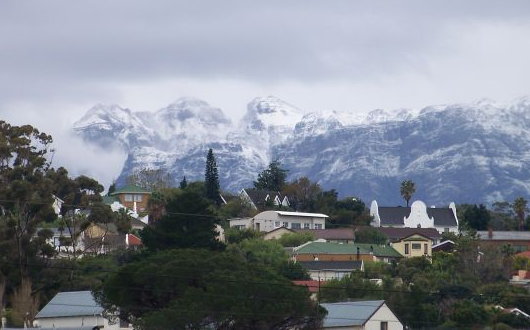
Some World Cup watchers found it slightly incongruous that as they balked in the heat of the northern summer, spectators in the stadiums were bundled up for the cold. It does snow in South Africa, though not every year and usually much less the closer you are to the sea (or rather sea-level). This recent photo distributed by Die Burger shows the Hottentots Holland range, near my former neck of the woods, capped with snow.
Even on days when you can see the mountain peaks topped in white, the temperature closer to the ground still allows you to spend a care-free afternoon relaxing at a vineyard with friends.
Three for the Army
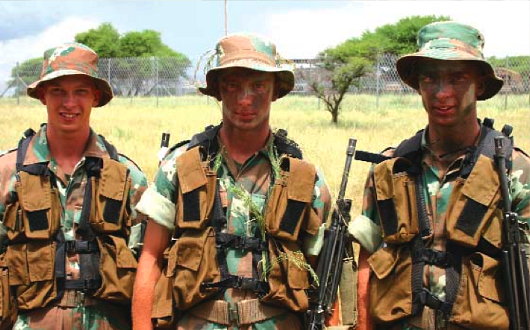
Something you don’t see every day: a set of triplets from Pretoria recently completed basic training as part of their enlistment in the South African Army. Dirk van Zyl, Tjaart van Zyl, and Hendrik van Zyl (above, left-to-right) are 20 years old and got their mechanical engineering qualifications before enlisting in the Defence Force.
The three brothers are all part of Foxtrot Company, 3 South African Infantry Battalion based at Kimberley in the Northern Cape; Hendrik in Platoon 1, Tjaart in Platoon 2, and Dirk in Platoon 3.
Large-scale operational deployments of the South African military have been few and far between since the country withdrew from the Angolan conflict and granted Namibia independence. Since then they have mostly consisted of United Nations and African Union peacekeeping operations, as well as other endeavours such as South Africa’s 1998 military intervention in a dynastic dispute in the neighbouring Catholic monarchy of Lesotho. Current defence regulations prevent siblings like the van Zyl brothers from being operationally deployed simultaneously.
Holland in die Kaap
’n Groep van Nederlanders in die Kaap het hulle Volkswagen Beetle in die Hollandse patriotiese kleure geverf om hul steun in die Sokkerwêreldbeker te vertoon en hul het hierdie vrolike YouTube video gemaak ook. (Hulle blog, in Nederlands, is 34 graden Zuid).
Watter span steun ek? Ach, baie! Teen Engeland, het ek die Verenigde State gesteun (maar ek haat die “Anyone-But-England” houding van baie in die Britse Eilande buite Engeland). Teen Duitsland, het ek die Aussies gesteun. En natuurlik al die Maties moet BAFANA BAFANA steun!
So vir groepe A-H (onderskeidelik) ons is vir Suid-Afrika, Argentinië, die VSA (of Engeland), Australië, Nederland, Nieu-Seeland, niemand in groep G, en Chili.
Unbuilt Cape Town: Municipal Offices
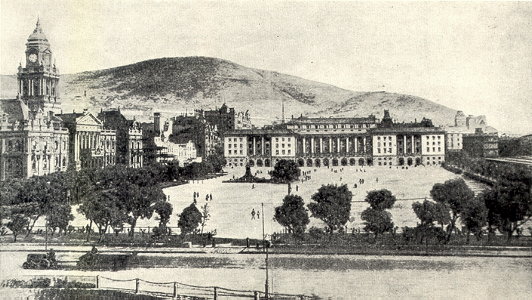
UNBUILT ARCHITECTURAL PROPOSALS fascinate me. Unfortunately most of the books documenting the more prominent examples of unbuilt buildings focus on space-age hyper-modernist ideas that never got off the drawing board, but these tend towards the tawdry and ridiculous. Far more interesting are the rejected proposals for buildings that did get built — for example the rival schemes to rebuild the Palace of Westminster after the 1834 fire — or this example of a proposal for a building never executed. I came upon these scheme thanks to the uploads of the Flickr user Berylmd. While Cape Town has a splendidly grand City Hall in an Edwardian Baroque style, the city fathers were unwise in providing insufficient space for the ever-blossoming municipal bureaucracy. This plan would have put a new municipal office building spanning the entire western side of the Grand Parade, replacing those little unremarkable market buildings whose existence on the square persists to this day. (more…)
Googlebosch
Google Street View Comes to the Eikestad and all South Africa
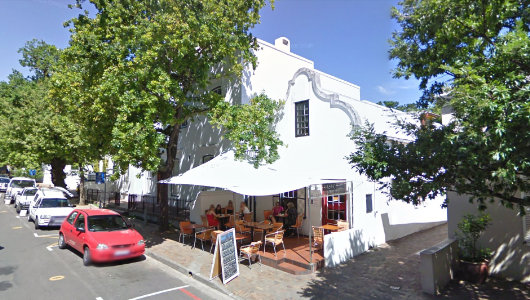
There had been rumours for a while. Talk had spread around the land of strangely equipped vehicles criss-crossing the country, and now the whole world can access Google Street View for South Africa. Naturally, they haven’t managed to capture every street in the whole country, but Cape Town, the Peninsula, and the Boland are well-covered, which naturally includes the handsome town of Stellenbosch that I used to call home. This of course provoked a mini-tour of the Eikestad and environs to see all the old familiar places. Above is Basic Bistro, the finest establishment in town, where one would oft find me planted outside with a pot of rooibos and the day’s edition of the Cape Times or Die Burger. The little alleyway to the right led to the back entrance to my old place. (more…)
Boom-studeer
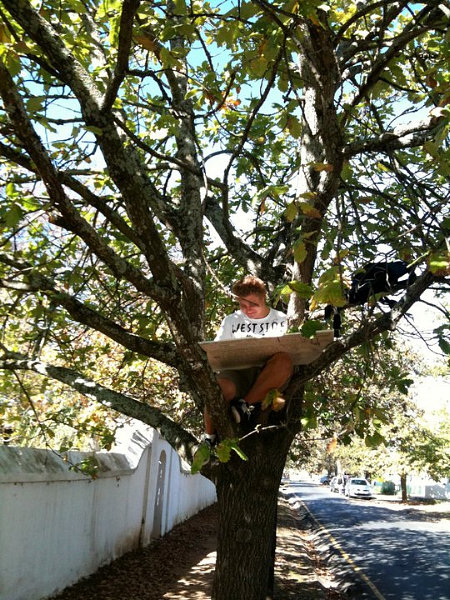
At Stellenbosch, when the J.S. Gericke Biblioteek is full-up, students must use their ingenuity to find other suitable locations where they can study for their exams.
The Versatility of the Cape Dutch Style
ORANJEZICHT IS ONE of my favourite parts of Cape Town, nestled in the bowl between Table Mountain and Signal Hill. Its name betrays it’s sloping location, which offers a view towards the Oranje bastion, one of the five of the Castle, which take their name from the titles of William, the Stadthouder of the United Provinces. The architecture is generally handsome, even if it often tends towards the Victorian. A few years ago, Cape Town Daily Photo featured a view (above) of the corner of Montrose Avenue and Bo-Oranjestraat in Oranjezicht. The late-autumn/early-winter street scene focusses on the Oranjezicht Carlucci’s, one of a small chain of delicatessens and wine shops founded in the mid-1990s.
The architecture of the shop is by no means in the strictest confines of the Cape Dutch style but is instead a more modern design influenced by the local architectural tradition of the Cape. While the Cape tradition is better known for larger country houses and wine-growing estates or small cottages, it’s just as useful a guide in the urban context. Dating the age of the building just by this photo would be tricky, as the region has some fairly convincing recent structures built in the old style (the dovecot at Alphen, for example), but I’d wager it’s 1900s-1910s construction that underwent a substantial renovation in the 1990s. (more…)
Frederik van Zyl Slabbert, 1940–2010
FREDERIK VAN ZYL SLABBERT, former South African parliamentarian, politician, and briefly chancellor of Stellenbosch university, died last week in Cape Town. ‘Van’, as he was known, was convinced after a night of heavy drinking to stand as a parliamentary candidate for the Progressive Party in 1974 and won a surprise victory in the Rondebosch constituency against the United Party incumbent by 1,600 votes. Within three years he became head of the merged Progressive Federal Party, and became Leader of the Opposition in the House of Assembly in 1979.
Koos van der Merwe, currently Chief Whip of the Inkatha Freedom Party, served in parliament alongside the liberal van Zyl Slabbert while the former was still a member of the Conservative Party. “He was a parliamentarian par excellence,” van der Merwe said after Van’s death, “and I remember how once, in a mere three-minute speech, he practically annihilated P. W. Botha.”
Despite wide acclaim as one of the finest debaters in parliament, van Zyl Slabbert shocked the political establishment in 1986 by resigning because he was convinced that parliament had become irrelevant to the running of the country. His resignation nearly ruined the PFP and frayed van Zyl Slabbert’s relationship with his fellow MP, the late Dame Helen Suzman.
Just a year later he organised the first meetings between members of the banned African National Congress and a group of National Party politicians, Afrikaner academics, and businessmen. In later years he co-founded a black investment trust, was appointed chairman of the Johannesburg Stock Exchange, sat on the boards of a number of South African corporations, and worked for the Open Society Foundation. Van Zyl Slabbert was appointed Chancellor of the University of Stellenbosch — for whom he had played rugby as an undergraduate — in 2008 but resigned for health reasons a year later, and was succeeded by Johann Rupert.
Mr. van der Merwe continued:
What amazed me about Van Zyl Slabbert was the depth of his political knowledge and his wisdom. He knew and understood the policies of each political party better than they did themselves. On one occasion, at a seminar in Williamsburg in the U.S.A., I represented the Conservative Party and was confronted with questions I could not answer. I asked to be excused for a few minutes and went to van Van Zyl Slabbert and asked him how I, as a Conservative MP, should answer. He immediately gave me the right answers because he fully understood the views and beliefs of the Conservatives. And for that matter, each and every political party. He was in fact a mobile political library.
When the late Dr Treurnicht’s daughter approached Van Zyl Slabbert for assistance to move to the U.S.A. to marry a black man, Van Zyl Slabbert did not use that information against Treurnicht. At that stage, it was unthinkable for a white Conservative to marry a black man. News of Treurnicht’s daughter marrying a black man would have led to the end of Treurnicht’s political career. Van Zyl Slabbert confidentially told me the story but it never made the headlines. What an honourable man!
His part in the struggle for Afrikaans at Stellenbosch was indeed an eye opener. Where were the Verkramptes? The old Conservatives of which I was a member? Nowhere. The fight for Afrikaans was led by the “liberal jingoes” such as Van Zyl Slabbert, Hermann Giliomee, and Breyten Breytenbach. …
I also never once saw him angry.
Mooi loop, Van Zyl. Koos gaan jou mis.
Requiescat in pace.
In a Stellenbosch Garden
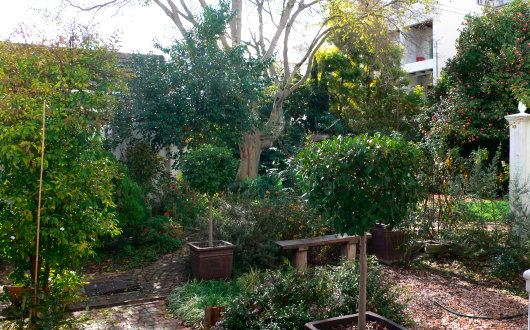
One of the pleasures of South Africa is that it is so conducive to the leafy things in life. Plants grow most of the year, so even while many of the trees may be bare, there is usually enough greenery about to keep things merry, as supported by the evidence of these shots of the garden of the little place in Stellenbosch where I used to live. Of course, this amenity to growth has its faults as well. Oak trees grow too quickly in this part of the world, leaving their wood too loose and unsuitable for use in barrelling. Wine- and brandy-makers must import their barrels from abroad, adding an irritating expense. Regardless of this incidental deficiency, South Africa still manages to produce some top-notch wines. (more…)
Search
Instagram: @andcusack
Click here for my Instagram photos.Most Recent Posts
- Gellner’s Prague December 19, 2024
- Monsieur Bayrou December 18, 2024
- Dempsey Heiner, Art Critic December 17, 2024
- Vote AR December 16, 2024
- Articles of Note: 12 December 2024 December 12, 2024
Most Recent Comments
Book Wishlist
Monthly Archives
Categories


